Summary:
"Dog nail trimming (or toenail or claw clipping) is necessary when the nails get too long, are torn or split. Long nails can get caught in gaps on wood decks, in carpet or on other surfaces, causing a tear. Active dogs often do not need to be cut as they naturally wear down when they come in contact with rough surfaces such as concrete walkways. Nails can grow to dangerous lengths if not naturally trimmed or clipped by an owner or groomer.
There are multiple types of nail trimmers which are described below. Guillotine style models are preferred by owners since they are easiest to use. Note that the nails on the rear legs are shorter and may not need to be trimmed as often as nails on the front legs. Start young so a dog gets used to sitting for a trimming. Only remove the last bit of nail that occurs after the "quick," which is the part with the book vessels and nerve endings (see below). Reinforce a positive experience with some petting, play or a treat after the nail clipping session is complete. Filing the nails after cutting can give them a smooth texture."
Overview
Unless a dog's nails naturally wear from walking on concrete or hard surfaces, an owner will need to clip the nails for health reasons. Paws become less efficient if the nails become overgrown, possibly deforming the shape of the toes (the nails can curve back into the paws) and feet. Long nails may also keep a dog from properly gripping the floor surface.
Here are some dog nail length basics:
- A dog's nails should not touch the ground when standing
- File or clip every 4 weeks (less often than human nails)
- Walking on payment will naturally file nails. Digging in dirt will do the same thing.
- Follow the directions below for acclimating a puppy to nail cutting
- Provide treats and positive praise to make it a rewarding experience for the dog
- Nail on the rear legs are shorter and require fewer dog nail trimming sessions
Dog Nail Clippers
Dog nail clippers come in two styles, the scissors or pliers type and the guillotine type, which have sliding replaceable blades. The guillotine type is considered easier to use on small and medium dogs, but the choice is up to the preference of the pet parent. The most important thing to know is to replace the blade often in order to make it as easy to cut the nail as possible without causing discomfort for your dog.
Use the scissors trimmer when a dog nail is long and curling. If claws grow too long then there is a risk that it will curl back into the toe-pad, something that occurs with the dew claws (claw on the inner paw). Since these are higher than the ground they do not wear down naturally.
Source : Amazon
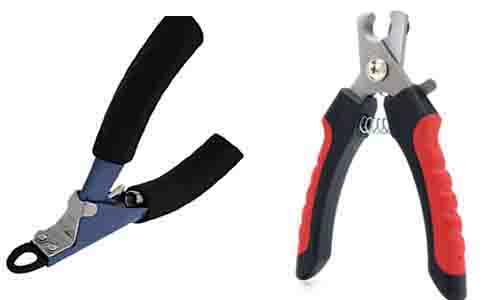
Dog Nail Grinder
A dog nail grinder such as the tool offered by Dremel is a sale alternative to dog nail trimming or clipping. It is a rotary dog nail grinder that slowing reduces the size each nail. When in use, be sure to alternate between nails every 3 seconds in order to keep the nails from heating. Like clippers, it is better to frequently grind the nails in smaller amounts in order to avoid the "quick" and bleeding.
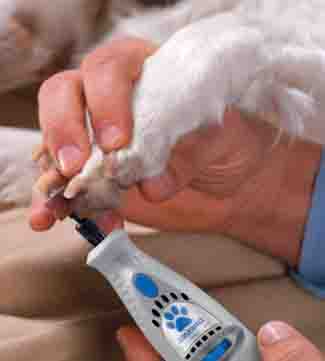
Photo Credit: Amazon (under $25)
Start Nail Clipping as a Puppy
Successful toenail cutting starts as a puppy. First, get your puppy used to having his paws touched. Start by touching or holding one paw and providing a treat. Then move and hold each leg successfully, providing a treat each time. Hold each paw for a few seconds before moving on to the next. Do not provide a treat when not holding the paw. Then do it again the next day, but hold the paw for a longer period of time. Repeat this for a few days. You can stop when your puppy is comfortable with you holding each paw for 30 seconds.
Get the Puppy Used to the Nail Clipper
Next, touch each paw briefly with the clipper while providing a treat at the same time. Do not clip the pups nails, just get him or her used to you holding the dog toenail clipper while touching the nails. Do the same as above. Start by touching the paw for a few seconds along with providing a treat. Move from paw to paw. Do not provide treats when not touching the paws.
Acclimate the Puppy to the Sound of the Clipper
This time, touch each paw with the clipper and squeeze the clipper without clipping a nail. Provide a treat each time. The goal is to get the puppy used to the sound of the clipper.
Clip the Puppy Toenails
Last, clip a little bit off of each toenail. Provide praise and treats each time. Err on the side of taking less of the nail for fear of cutting into the quick (the part of the nail with nerve endings and blood vessels).
Dog Nail Clipping Desensitization Training Suggestions
If you have an older dog that resists dog nail trimming sessions then follow this simple advice:
- Familiarize: leave the nail clipper on the floor where your dog will find it. Just leave them out so the clipper becomes a familiar object.
- Touch: You'll want your dog to touch the clippers. Place a treat near the clippers. If your dog still avoids the clipper, then move the treat farther away until he take the treat. Over time move the treat closer. Do this when the dog is hungry (before dinner) to make the treats more tempting.
- Connect the Clippers To You: Sit next to the clipper and command your dog to sit next to you. Gesture to the clippers and say "touch." When your dog does as requested provide a treat or praise. Whatever works as a reward for your dog. Repeat several times to get your dog used to associating the clippers with a reward.
- Connect the Clippers to the Dog's Nails: Sit next to the clippers and have your dog sit next to you. Next pick up the clipper and touch a front paw and nail. Do not clip. This is just to associate the clipper to the nails. When he pulls his paw away, you look away and look disappointed and say "too bad." When your dog holds still while the clipper is touching the nail provide a treat. Wait a day before touching two paws and then provide a treat. If you can't get your dog to hold still while the clipper is touching a nail, then reward for coming close. The next time don't provide a treat until you are closer. The next time until you touch a nail and the dog holds the paw to the clipper. Basically you require more each time you provide a treat.
- Clip the Nails: By now your dog should be used to having the clipper touch the nails. Clip the nails on one paw and provide a reward. After several days, or a few days and sessions per day, your dog will be wanting you to clip the nails in order to get a reward.
How to Restrain a Dog Before Clipping Nails

While some dogs will sit for a toe nail clippings, others will not. To keep a dog from moving during the dog nail trimming session, place your dog on a table. Stand opposite to the side with the paws that will be clipped. Place your left forearm over the dog's neck to keep the head from lifting up. Next, place the paw with the nails to be clipped in your left hand while holding the dog nail clipper in your right.
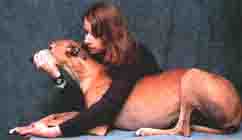
The entire procedure is easier if you ask another family member to restrain the dog while you do the dog nail trimming. The person holding the dog should hold the muzzle and turn it away from the person trimming the nails. The person holding the dog can also use the right hand to help steady the leg with the paw being trimmed. If the dog raises it's rear, use your body to keep the dog from rising.
Larger dogs are sometimes easier as they can sit on the floor while being restrained.
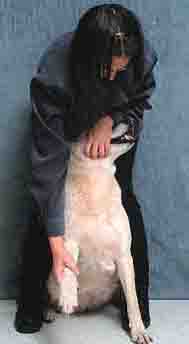
Trimming the Dog Dew Claw
The dew claw is on the inside of the paw. It is connected to the dog with loose skin and can be bent from the leg. Use a guillotine trimmer over the tip when trimming the dew claw. Note that some dew claws are removed as puppies. Some breeds (St. Bernard) have 2 sets of dew claws on the back legs.
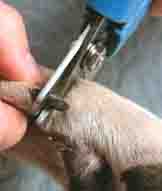
How to Trim Dog Nails
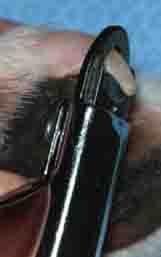
The dog nail should not be trimmed all the way back, but only to within 2 millimeters of what is called the "quick." The quick will grow in size with the nail, and then recede as the nail is trimmed. Doing a bit at a time is a solution if the quick extends too far into the nail.
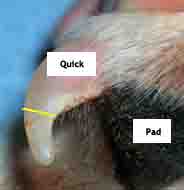
Trimming Dark Colored Dog Nails
If your dog has darker colored nails it is harder to see the quick. In this case take smaller cuts no longer than 1/16th of an inch. By looking at the nail straight on you should be able to see a small dark circle in the center of the nail.
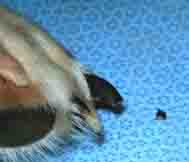
As you cut deeper into the toenail, a pink/gray oval will be seen on the top of the cut surface of the nail. Do not cut into this area to avoid cutting into the quick in order to avoid any nail bleeding.
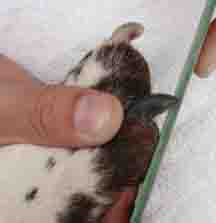
How to Stop Dog Nail Bleeding
To stop any dog nail bleeding, apply a styptic pencil that contains silver nitrate. Hold the stick against the nail until the bleeding stops or use a product such as Kwik Stop styptic powder. Don't worry about a bleeding dog nail. While you might see a good amount of blood, it will not hurt the dog as long as you can apply the products mentioned which will get the blood to stop.
Brochure Downloads
References for Dog Nail Trimming
Jeff Grill
